Wind-powered Sail Cars: Doing Fun Science at Home during School Closures (Activity #20)
Follow along with a Science Buddies parent who is using family STEM activities to keep her kids learning at home during the COVID-19 school shutdown. New posts every Monday, Wednesday, and Friday. Today's adventure... building a beast of a wind-powered sail car.
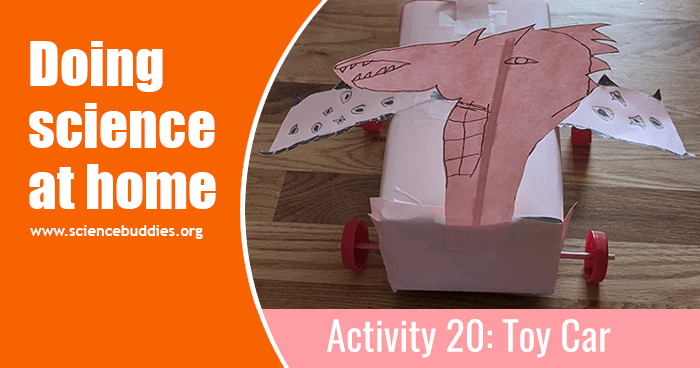
Building Your Dream Toy Car
Does your child ever wish for a toy that doesn't exist? Although I don't recall my seventh-grade son doing so, my second-grade daughter has done this for years. She pictures in her mind a perfect toy, usually one that matches an imagination-based game she's created, and then she asks for help to scour the Internet to find it only to be disappointed that it doesn't exist. I keep telling her she's going to be a toy inventor when she grows up.
I think lots of kids have visions like this of their "dream" toy, which is why I love science and engineering projects that encourage kids to design and build their own toys. We've already done a couple of different toy-building projects in the last eight weeks of quarantine, including: kites, toy parachutes, rubber band guitars, air cannons, and cotton-ball launchers. Today we turned to another great category of toy-building: toy cars.
Building a toy car can be a simple project, or it can be as elaborate as your child wants it to be. The goal is to allow them total freedom to build their dream toy car out of whatever materials they can scrounge up around the house. The goal is some kind of vehicle that can move from one spot to another. What it looks like and how it is powered is up to the builder. This kind of open-ended building is all about sharpening those creativity and problem-solving skills while being rewarded by something highly desirable — a new toy!
There are two approaches to getting started. The first is to leave it very open-ended and simply have your child watch our video that steps through some of the basic choices they'll need to make when designing and building their car:
The second approach is to pick a specific style of car beforehand, so that there are fewer choices for your child to make as they design the car. (You might also pre-select a style of car in advance based on materials you know you have.) Here are a couple of car styles to choose from:
- Build a Wind-Powered Car: attach a sail to your car and use a fan to send it zooming across the floor.
- Build a Rubber Band-Powered Car: this wind-up version has a limited travel range but can be pretty zippy with the right rubber band.
- Balloon car lesson plan: this video gives an overview of how to propel a car by releasing air from a balloon.
If you are looking for a bigger project with an emphasis on circuit building, you can design and build a solar-powered car instead. This isn't a one-day adventure though and is best for older kids or as a family project with fourth grade and up.
My Pick of the Day: Wind Powered Sail Car
I started the day by giving my kids three science activities to choose from. Amazingly (like minor miracle kind of amazing) they agreed on building toy cars. I showed them the general car building video and brought out the bin of recycled goods I've been collecting for projects. There were only a few plastic milk bottle caps. Because these show up in the video as an option for wheels, these were immediately prized materials. My son generously gave them to his little sister and then spent his project time experimenting with different wheel, axel, and chassis setups. He's forbidden me from showing them off since he's "not finished with them, Mom." I can respect that, so I'll share what my daughter built instead.
From the very beginning, my daughter had a clear idea of what she wanted to build. In essence, it ended up being a wind-powered sail car, but it wasn't quite as simple as the one in this video:
Instead of making an ordinary car, my daughter wanted to make one that was modeled after a beast. If you've been following along, you may have clued in by now to the fact that she's quite the fan of mythical creatures — hence the dragon on her kite and the fantastical beasts in her mobile. Lately she's been playing a Nintendo DS game called Monster Hunter Stories and wanted to recreate the Pink Rathian, a wyvern-like monster, for her car. Since the character flies, she decided the car version should be wind powered.
For the wheels, she used the milk bottle caps her brother gifted her. After she marked the center of each cap, I poked holes using the craft knife. She then used straws and wooden skewers to create the axels. Both axels were taped to the underside of an empty tissue box that she covered in pink construction paper.
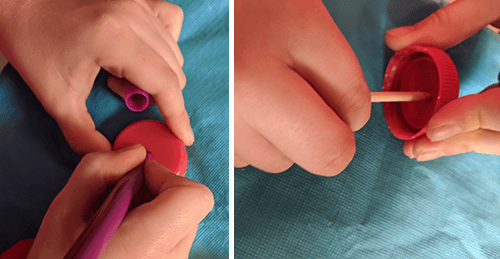
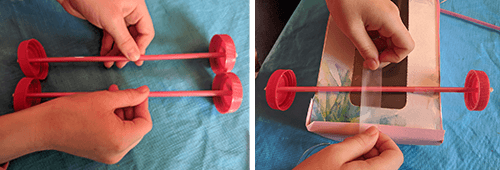
Next it was time for the artistry — creating a head, wings, and tail for her beast-car. We had a bit of a discussion about what body parts would work as her sail. We talked about the fact that some sailboats have multiple sails, and I suggested that several body parts, including the wings, should be part of her sail system. She informed me that the wings couldn't be part of the sail because she wanted them to lie flat, parallel to the ground, as they came out of the beast's back. The tail also needed to be flat she told me, but her Rathian could have a long neck and large head to function as the sail. I wondered if that would be enough surface area, but I know that developing something new often involves prototyping and then making changes to solve problems. That kind of troubleshooting is a valuable part of this kind of hands-on STEM activity. I kept quiet and let her build her car the way she envisioned it.
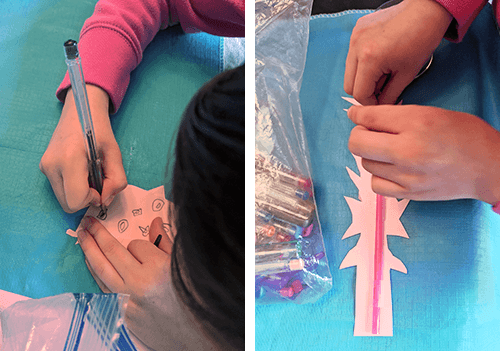
It took a bit of trial and error to get the various body parts placed the way she wanted them. The tail and head both required straw supports to stay rigid. In the end, her vision worked exactly as she intended; when placed in front of the fan, her beast-car glided across the floor smoothly. Best of all, she was very proud of having designed and built her new toy herself.
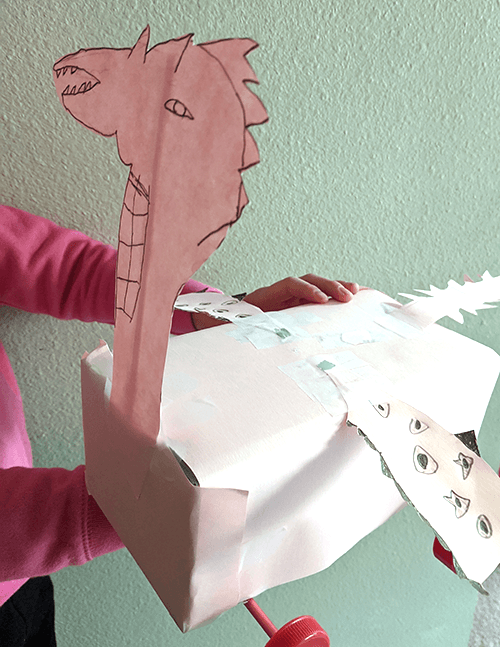
If your kids build toy cars, we'd love to see. Post a picture of what they make on social media and tag us. You can find us on Twitter, Facebook, and Instagram.
If this blog post was useful to you, please share it with other parents. Follow the links below to see what other science adventures we've been having at home.
View All Posts in this Series
- Activity 1 - Getting Started and Hand Washing
- Activity 2 - Taking Flight with Kites
- Activity 3 - Candle Seesaw and Fire Science
- Activity 4 - Dissecting Flowers
- Activity 5 - Building a Toy Parachute
- Activity 6 - Paper Marbling
- Activity 7 - Shaping Hard-boiled Eggs
- Activity 8 - Invisible Ink
- Activity 9 - Robot Hand
- Activity 10 - Plastic Egg Rockets
- Activity 11 - Rubber Band Guitar
- Activity 12 - Making Model Viruses
- Activity 13 - Air Cannons
- Activity 14 - Balancing an Art Mobile
- Activity 15 - Gumdrop Geometry
- Activity 16 - Solar Updraft Tower
- Activity 17 - Cotton Ball Launcher
- Activity 18 - Wire Water Striders
- Activity 19 - Ice Cream in a Bag
- Activity 20 - Wind-powered Sail Cars
- Activity 21 - Curling Metal
- Activity 22 - Popsicle Stick Catapult
- Activity 23 - Candy Diffusion
- Activity 24 - STEM Videos
- Activity 25 - Making Slime
- Activity 26 - Straw Siphon
- Activity 27 - Elephant Toothpaste
- Activity 28 - Balloon Hovercraft
- Activity 29 - Aluminum Foil Boats
- Activity 30 - Wall Marble Run
A science activity log is available as a Word document or as a Google doc for online convenience. (Just choose "File/Make a copy" to save it to your Google Drive.)
About the Author
Sandra, Science Buddies' Vice President of STEM education, holds a PhD in Genetics from Stanford University and has spent the last twelve years working on science education and STEM outreach. Right now, she's stuck working from her home in the Pacific Northwest with her husband, second grader, middle schooler, and two oddly noisy gerbils. She hypothesizes her sanity will hold as long as she gets a daily dose of sunshine.
Categories:
You Might Also Enjoy These Related Posts:
- Wall Marble Run: Doing Fun Science at Home during School Closures (Activity #30)
- Aluminum Foil Boats: Doing Fun Science at Home during School Closures (Activity #29)
- Hovercraft: Doing Fun Science at Home during School Closures (Activity #28)
- Elephant Toothpaste: Doing Fun Science at Home during School Closures (Activity #27)
- Straw Siphon: Doing Fun Science at Home during School Closures (Activity #26)
- Slime Three Ways: Doing Fun Science at Home during School Closures (Activity #25)
- A STEM Videos Breather: Doing Fun Science at Home during School Closures (Activity #24)
- Candy Experiments: Doing Fun Science at Home during School Closures (Activity #23)











